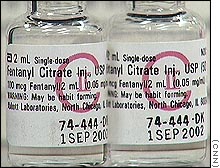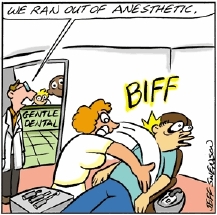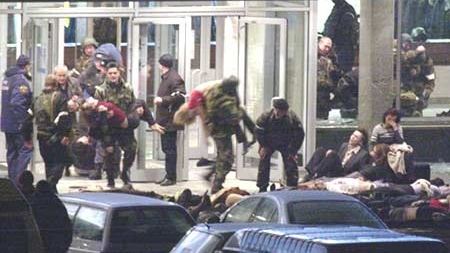
 | Preparation of fentanyl, a synthetic narcotic analgesic |
Fentanyl belongs to a group of medicines called narcotic analgesics. It was first synthesized in the late 1950s by Janssen Pharmaceutica in Belgium [1] and was introduced into medical practice in the 1960s as an intravenous anesthetic under the trade name Sublimaze®. Shortly thereafter, two other fentanyl analogues were put on the market: alfentanil (Alfenta®), an ultra-short (5-10 minutes) acting analgesic, and sufentanil (Sufenta®), an exceptionally potent analgesic for use in heart surgery.
| Today, fentanyl derivatives remain the most potent narcotics available for clinical use (50 to 100 times more potent than morphine). They are extensively used for anesthesia and analgesia. Duragesic®, for example, is a fentanyl transdermal patch used in chronic pain management, and Actiq® is a solid formulation of fentanyl citrate on a stick that dissolves slowly in the mouth for transmucosal absorption. Actiq® is intended for opiate-tolerant individuals and is effective in treating breakthrough pain in cancer patients. Carfentanil (Wildnil®) is an analogue of fentanyl with an analgesic potency 10,000 times superior to morphine, which is used in veterinary practice to immobilize certain large animals. |  |
The fentanyl derivatives have all the properties of the opiates and opioids, yet are chemically unrelated, and therefore do not cross-react with any of the reagents used in opiate screening tests. Illicit use of pharmaceutical fentanyls first appeared in the mid-1970s in the medical community and continues to be a problem in the United States [2]. To date, over 12 different analogues of fentanyl have been produced clandestinely and identified in the U.S. drug traffic. The biological effects of fentanyl street drugs are indistinguishable from those of heroin, with the exception that the fentanyls may be hundreds of times more potent. Fentanyls are most commonly used by intravenous administration, but like heroin, they may also be smoked or snorted.

On October 23, 2002 Chechen terrorists led by Movsar Barayev seized the House of Culture for the State Ball-Bearing Plant Number 1, a Moscow theater, during a sold out performance of Nord-Ost. Taking over 700 patrons and performers hostage, they demanded the immediate and unconditional withdrawal of Russian forces from Chechnya. Early Saturday morning, October 26, forces from Russia's elite Spetsnaz commando unit of the Federal Security Services pumped sleeping gas into the theater through a hole in the wall and then stormed the building. At least 50 terrorists and 120 hostages died in the raid or shortly thereafter. Efforts to treat victims were complicated because the Russian government initially refused to reveal even to medical personnel- what type of anesthetic had been used, the concentration deployed, and possible antidotes. Foreign embassies in Moscow issued official requests for more information on the gas to aid in treatment, but were publicly ignored. On Wednesday, October 30, Russia responded to increasing domestic and international pressure with a statement from Health Minister Yuri Shevchenko. He identified the unknown gas as an aerosol of a fentanyl derivative. Although Shevchenko did not mention use of any other agent, German toxicologists who examined several German hostages said that their blood and urine contained halothane (CF3CHBrCl), a surgical anesthetic not commonly used in the West, and that the gas most likely had additional components [3].
The synthesis of fentanyl (N-phenyl-N-(1-phenethyl-4-piperidinyl)propanamide) was achieved in four steps starting from 4-piperidinone hydrochloride. This precursor was first reacted with phenethyl bromide to give N-phenethyl-4-piperidinone (NPP). Treatment of the NPP intermediate with aniline followed by reduction with sodium borohydride afforded 4-anilino-N-phenethyl-piperidine (ANPP). A final reaction between ANPP and propionic anhydride led to the target product in 47% overall yield.

A suspension of finely powdered sodium carbonate (53 g, 0.5 mol) and sodium iodide (0.5 g) in 250 mL of acetonitrile was heated to 60 °C before 4-piperidinone hydrochloride (67.80 g, 0.5 mol) was added in portions small enough, so that the gas evolution was not too vigorous. Phenethyl bromide (92.53 g, 0.5 mol) was then added dropwise and the reaction mixture was refluxed for 24 h. After cooling to room temperature, the precipitate was filtered off and rinsed with a small portion of acetonitrile. The filtrate was concentrated on a rotary evaporator to afford NPP as a slightly yellow solid (96% yield, m.p. 59-63 °C).
2. Synthesis of the imine derivative of NPPAniline (23.28 g, 0.25 mol). was added to a stirred solution of NPP (50.82 g, 0.25 mol) and p-toluenesulfonic acid monohydrate (0.1 g) in 500 mL of toluene. The reaction mixture was refluxed for 22 h using a Dean-Stark trap. It was then cooled to room temperature and diluted with 500 mL of ethanol. The resulting solution containing the imine derivative of NPP could be used for the next step without any further treatment.
3. Synthesis of 4-anilino-N-phenethyl-piperidine (ANPP)Sodium borohydride (9.46 g, 0.25 mol) was added in small portions to the stirred solution containing the imine derivative of NPP, causing evolution of gas and a lightening in color. At the end of the addition, the mixture was further stirred for 3 h at room temperature. Water (200 mL) was added dropwise and the pH of the aqueous phase was adjusted to 3 with 10% hydrochloric acid. The layers were separated and the aqueous phase was washed with toluene (600 mL). The aqueous layer was then made strongly basic by addition of a 50% sodium hydroxide solution and extracted with dichloromethane (3 x 450 mL). The combined organic phases were dried and concentrated on a rotary evaporator to give crude ANPP as a yellow-orange oil that spontaneously crystallized into a yellow solid (88% yield, m.p. 96-98 °C).
4. Synthesis of N-phenyl-N-(1-phenethyl-4-piperidinyl)propanamide (fentanyl)Propionic anhydride (4.8 g, 0.037 mol) was added to a stirred solution of ANPP (8.41 g, 0.03 mol) in 80 mL of toluene. The reaction mixture was refluxed for 2 h, cooled to room temperature and poured over ice (50 g). The pH of the aqueous phase was adjusted to 12 with 10% sodium hydroxide. Stirring was continued for 15 min after the addition of the base was complete. The layers were separated and the aqueous phase was extracted with toluene (2 x 100 mL). The combined toluene extracts were dried and evaporated to afford a brown oil that solidified on standing. Pure fentanyl was isolated as a white solid after recrystallization from diethyl ether (56% yield, m.p. 83-84 °C).
[1] P. A. J. Janssen, US Pat. 3,164,600 (1965).
[2] G. L. Henderson, J. Forensic Sci. 33, 569-575 (1988).
[3] L. Ember, Chem. Eng. News November 4, 6 (2002).
[4] G. A. Brine, K. G. Boldt, P.-T. Huang, D. K. Sawyer, F. I. Carroll, J. Heterocycl. Chem. 26, 677-686 (1989).
Nom : .............................
Prénom : ..........................
Sart-Tilman, le 18 novembre 2003
Sur base du schéma réactionnel et des modes opératoires ci-joints, répondez de façon brève, claire et précise aux questions suivantes. Vos réponses doivent se trouver uniquement dans les espaces prévus à cet effet, sur les faces recto des feuilles. Les faces verso peuvent être utilisées comme brouillons. Toutes vos équations chimiques doivent être complètes et équilibrées. Soignez les dessins de structures chimiques et de montages expérimentaux.
Thème I. Synthèse de la N-phénéthyl-4-piperidinone (NPP)
1) Proposez un mécanisme détaillé pour la transformation de l'hydrochlorure de 4-pipéridinone en NPP. Indiquez clairement sur votre schéma la structure de la NPP. Discutez la validité de votre mécanisme sur base de la nature du substrat et des conditions expérimentales adoptées. (4 points)

![]()
![]()
4) Proposez une équation moléculaire équilibrée rendant compte de la transformation de la NPP en son imine dans les conditions expérimentales adoptées. Indiquez clairement sur votre schéma la structure de l'imine de la NPP. (2 points)

![]()


8) Représentez la structure de l'ANPP. (1 point)

![]()
![]()
11) Proposez une équation moléculaire équilibrée rendant compte de la transformation de l'ANPP en fentanyl dans les conditions expérimentales adoptées. Indiquez clairement sur votre schéma la structure du fentanyl. (2 points)

![]()


Retour au sommaire des interrogations Retour au sommaire de /licence/